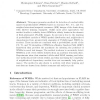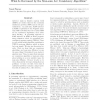595 search results - page 94 / 119 » Multi-robot Markov random fields |
MICCAI
2003
Springer
14 years 11 months ago
2003
Springer
We present a new brain segmentation framework which we apply to T1-weighted magnetic resonance image segmentation. The innovation of the algorithm in comparison to the state-of-the...
MICCAI
2004
Springer
14 years 11 months ago
2004
Springer
This paper presents an approach for deformable registration of a normal brain atlas to visible anatomic structures in a tumor-diseased brain image. We restrict our attention to cor...
IPMI
2009
Springer
14 years 11 months ago
2009
Springer
This paper presents a method for detection of cerebral white matter hyperintensities (WMH) based on run-time PD-, T1-, and T2weighted structural magnetic resonance (MR) images of t...
ICML
2007
IEEE
14 years 11 months ago
2007
IEEE
Inference tasks in Markov random fields (MRFs) are closely related to the constraint satisfaction problem (CSP) and its soft generalizations. In particular, MAP inference in MRF i...
ICML
2008
IEEE
14 years 11 months ago
2008
IEEE
While discriminative training (e.g., CRF, structural SVM) holds much promise for machine translation, image segmentation, and clustering, the complex inference these applications ...


